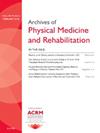Association of Patient Characteristics With Recovery in Adults With Disorders of Consciousness
IF 3.7
2区 医学
Q1 REHABILITATION
Archives of physical medicine and rehabilitation
Pub Date : 2025-10-01
DOI:10.1016/j.apmr.2025.04.011
引用次数: 0
Abstract
Objective
To describe the characteristics of patients enrolled in disorders of consciousness (DoC) rehabilitation programs and to examine factors associated with improvement beyond measurement error on neurobehavioral function. Outcomes for adults with DoC after severe brain injury are highly variable and difficult to predict. Applying a minimal detectable change (MDC) threshold to change measures can identify help to distinguish true improvement or decline from random fluctuation. We also evaluated whether change in neurobehavioral function during the first 2 weeks of rehabilitation was associated with change between 2 and 4 weeks.
Design
Retrospective cohort study. Data were generated as part of standard clinical care.
Setting
Postacute inpatient facilities with specialized DoC programs at 2 large, urban health care systems.
Participants
Adults with DoC after severe brain injury (N=696).
Interventions
Not applicable.
Main Outcome Measure
Improvement beyond measurement error, calculated as the MDC with a 90% confidence interval (9 units) on the Coma Recovery Scale-Revised (CRS-R), using an equal-interval 0-100 unit transformed total measure. The MDC threshold was applied to change in CRS-R total measure from first to last CRS-R administration (up to 60 elapsed).
Results
Two-thirds of the sample (n=445) improved beyond the MDC on the CRS-R; 23 participants declined beyond measurement error, and 228 participants changed less than the MDC. Patients with less time elapsed between injury and first CRS-R assessment were more likely to improve beyond the MDC. Change during the first 2 weeks of rehabilitation was not associated with change between 2 and 4 weeks.
Conclusions
Our results underscore the importance of measuring change with greater precision for adults with DoC, as within-state change (or lack thereof) could inform rehabilitation treatment decisions about whether interventions are working as intended.
成人意识障碍患者特征与康复的关系。
目的:描述参加意识障碍(DoC)康复计划的患者的特征,并探讨神经行为功能改善的相关因素。成人重度脑损伤后DoC的预后变化很大,难以预测。应用最小可检测变化(最小可检测变化)阈值来更改度量可以识别帮助,以区分真正的改进或下降与随机波动。我们还评估了康复前两周神经行为功能的变化是否与两到四周的变化相关。设计:回顾性队列研究。数据是作为标准临床护理的一部分生成的。环境:在两个大型城市医疗保健系统中设有专门的DoC项目的急性住院设施。参与者:重度脑损伤后伴有DoC的成人(N=696)。干预措施:不适用。主要结果测量:测量误差之外的改善(计算为最小可检测变化(MDC),在昏迷恢复量表修订(CRS-R)上具有90%的置信区间(9个单位),使用等间隔0-100单位转换的总测量。MDC阈值应用于从第一次到最后一次CRS-R管理(最多60个时间)的CRS-R总度量的变化。结果:三分之二的样本(n=445)的CRS-R改善超过MDC;n=23的下降超出了测量误差,n=228的变化小于MDC。受伤和首次CRS-R评估之间时间间隔较短的患者更有可能在MDC之后得到改善。康复前两周的变化与两到四周的变化无关。结论:我们的研究结果强调了更精确地测量DoC成人变化的重要性,因为状态内变化(或缺乏状态变化)可以为康复治疗决策提供信息,以确定干预措施是否如预期的那样起作用。
本文章由计算机程序翻译,如有差异,请以英文原文为准。
求助全文
约1分钟内获得全文
求助全文
来源期刊
CiteScore
6.20
自引率
4.70%
发文量
495
审稿时长
38 days
期刊介绍:
The Archives of Physical Medicine and Rehabilitation publishes original, peer-reviewed research and clinical reports on important trends and developments in physical medicine and rehabilitation and related fields. This international journal brings researchers and clinicians authoritative information on the therapeutic utilization of physical, behavioral and pharmaceutical agents in providing comprehensive care for individuals with chronic illness and disabilities.
Archives began publication in 1920, publishes monthly, and is the official journal of the American Congress of Rehabilitation Medicine. Its papers are cited more often than any other rehabilitation journal.

 求助内容:
求助内容: 应助结果提醒方式:
应助结果提醒方式:


